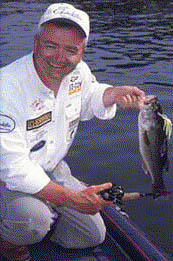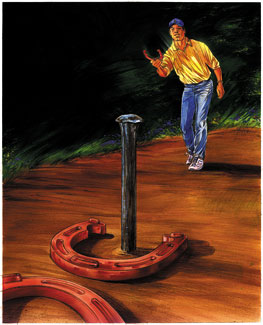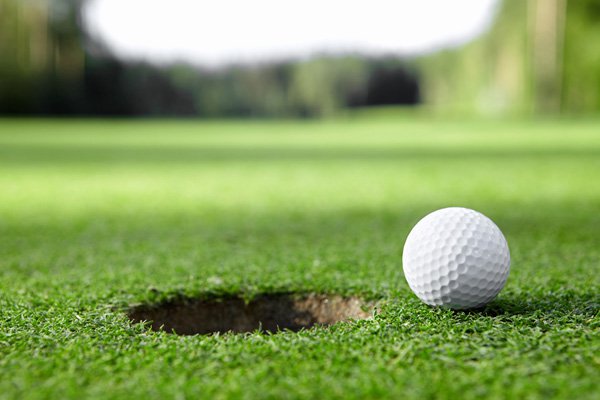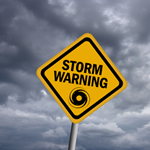My first tournament of the 1999 season took me to the Potomac River. Located between Maryland and Virginia, the Potomac River is without doubt one of the premiere fishing locations on the eastern seaboard. River fishing for bass is tough. So many factors play a role in the presentation, location and color selection. The Susquehanna River in Maryland, the St. Lawrence River on the US and Canadian border and the St. Johns River in Florida have left me with physical and mental scars, including memories of lost fish, lost opportunity, lost equipment and a several close, personal looks at Mother Natures awesome power. The Potomac this day would be no exception. With a stalled storm over the Atlantic Ocean, wind and high tides caused havoc for the fishermen. During official tournament practice on Saturday, I had damaged my boat in only 20 minutes of battling the waves and wind. I was now a non-boater. Add to that the prospect of bad weather for the following day and I began wondering if it could get any worse. Sunday morning showed no promise of change as we waited patiently for the start of the tournament. I watched as 200 boats were rocked from side to side by turbulence. How rough would it be I wondered, when we took off for Nanjamoy Creek (normally a 40 minute run). When our number (boat 117) was finally called, we moved out into the main river channel. Almost immediately, waves hit us from both sides as we pushed southward on our journey. As each wave would hit, we were thrown upwards by the force of the water, only to come crashing downward into our seat. The force of impact sends a jarring pain, searing through the spine and into the skull like a kick from a steel boot, but you just keep going. Suddenly and without warning, a large wave appeared in our path. It was too late to turn and too late to avoid.

Charles Stuart
We hit the wave full force and watched helplessly as the electronics located at the bow the boat were ripped from the mounting and slid along the flat casting platform towards us. As we pressed on, equipment straps began to give way and rods bounced towards me. Rob, who was driving the boat, battled with cross winds and waves with each passing moment. The next large wave that hit us ripped the electronics and windshield from its bolted mount in front of Rob's face. How he was not injured still remains a mystery to me. We were now without depth, temperature or location electronics. With no shoreline in sight and the waves continually beating us from all sides, we had no choice but to proceed.
After what seemed like an eternity, (one hour and 40 minutes) we reached our destination. Gathering our thoughts and equipment, we began fishing. The creek provided us with some shelter from the wind and current and soon the journey seems a distant memory. (Fishing can do that!). The size limit for the Potomac is 15 inches. That is a two-pound plus fish, so catching them to size proved a daunting task. Between us, we caught and released forty fish in the 13 and 14-inch size range. Rob finally caught the only keeper a 15-inch fish but we were now facing an out going tide that bought the fishing to an abrupt halt. We searched for a few more fish in vain and decided we should begin our journey back to the launch site and weigh in the only legal fish of the day. We tried to be optimistic about the journey back, hoping that the wind would be at our backs and that the turbulence has in someway subsided. How wrong we were! Once we left the bay, the wind lifted us into the raging river system once again.
Pressing onward, we hit large waves similar to those we had seen in the morning. The trolling motor on the bow was ripped from its "gator mount" and plunged into the water causing a large spray to cover us both from head to toe. Rob cut the engine and I tied the motor down to secure it and protect us both from the possibility of it breaking free and hitting us full in the face, (A trolling motor weighs approximately 40 pounds. With a gator mount, that is increased to near 70 pounds) not a pleasant event! As we moved on, we began to notice water coming into the lower deck area around our feet. Rob turned on the bilge only to find that the unit had failed. Now we were beginning to fill with water and still had several miles to go before reaching safety. After almost two hours, we finally pulled into Mattawoman Creek opposite the launch site. Here we tried to find out what was wrong with the bilge, but with so much water in the boat, there was little we could do. With time almost run out, we had to make a final crossing of the river at one of the widest points. When Rob tried to get the boat on plane, we became lower in the water at the rear of the boat. The only solution was for me to sit on the bow and counterbalance the boat so that we could attain enough speed. I had to perform this function twice before we got back to shore.
Just when we thought it could not get any worse, the wind picked up again and began rocking the boats tied to the moorings. We could not prevent the boat from being pounded into the dock and other vessels tied close by. So great was the force of the wind that the boat cleats were ripped from the bodywork. Rob went for the truck and trailer and I took the boat out from the area and moved along the shoreline where some other fishermen had tied their boats. Throwing a line to the shore, the boat was "secured" and I waited for the trailer to be reversed onto the ramp to remove the boat from the water. While waiting, I timed the water coming into the boat as around an inch every five minutes. We had just made it back!
By the time we got the boat out of the water, the lower deck area was full. As we raised the boat onto the trailer, Rob turned to me and asked, "have you ever had worse?" To which I replied yes I had. (I will tell that story another day) But I also added that today was a good day!
"A good day," said Rob, "Why is that?"
I told him today was a good day because we made it back to the dock.
"So what's a bad day?"
"Do I really need to tell you that?!"
 Charles Stuart
We hit the wave full force and watched helplessly as the electronics located at the bow the boat were ripped from the mounting and slid along the flat casting platform towards us. As we pressed on, equipment straps began to give way and rods bounced towards me. Rob, who was driving the boat, battled with cross winds and waves with each passing moment. The next large wave that hit us ripped the electronics and windshield from its bolted mount in front of Rob's face. How he was not injured still remains a mystery to me. We were now without depth, temperature or location electronics. With no shoreline in sight and the waves continually beating us from all sides, we had no choice but to proceed.
Charles Stuart
We hit the wave full force and watched helplessly as the electronics located at the bow the boat were ripped from the mounting and slid along the flat casting platform towards us. As we pressed on, equipment straps began to give way and rods bounced towards me. Rob, who was driving the boat, battled with cross winds and waves with each passing moment. The next large wave that hit us ripped the electronics and windshield from its bolted mount in front of Rob's face. How he was not injured still remains a mystery to me. We were now without depth, temperature or location electronics. With no shoreline in sight and the waves continually beating us from all sides, we had no choice but to proceed.


